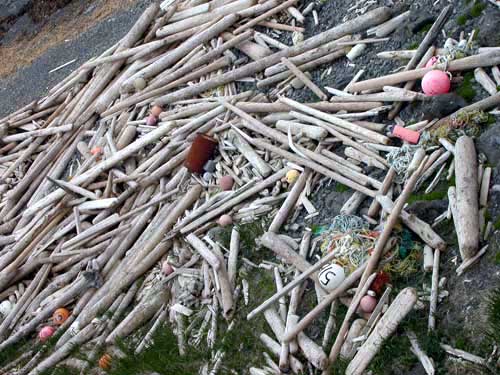 Scientists to take driftwood
expedition this summer
Scientists to take driftwood
expedition this summer
By Ned Rozell
May 16, 2007
Wednesday
The Thule people who lived in the High Arctic 1,000 years ago
left behind spruce carvings that intrigue archaeologist Claire
Alix because the Thule lived hundreds of miles from the nearest
living tree. Their only source of wood was what drifted in from
places unknown.
"Wood is well preserved in archaeological sites," said
Alix, an archaeologist with the Alaska Quaternary Center at the
University of Alaska Fairbanks. "It's really plentiful in
sites of (the Thule) period."
Driftwood logs have tales to tell about past river and ocean
circulation and climate, and Alix is one of the few scientists
who study driftwood. When trees fall from the bank of a great
river like the Yukon, Mackenzie, or the Anadyr in Siberia, they
sometimes travel thousands of miles to the ocean. Once in the
ocean, a Yukon spruce log can reach the eastern Arctic via Fram
Straight, riding ice floes for a good portion of the way and
taking many years to complete the trip.
 A pile of driftwood,
off a western Aleutian island.
A pile of driftwood,
off a western Aleutian island.
Photo by Ned Rozell
Alix once traced a spruce log gathered by Steven Stone in Hooper
Bay to an area near Beaver, Alaska, about 900 miles from Hooper
Bay. By matching up growth rings on the log to rings of live
trees from the Beaver area, she found that the spruce tree had
fallen in the Yukon near Beaver in 1999 and took four years to
drift to Hooper Bay on the Bering Sea coast, where large trees
don't grow. In Hooper Bay and villages beyond treeline, residents
look forward to the spring days after ice breakup when driftwood
from the interior of the continent floats to their village.
"It's still a very important resource in places like Hooper
Bay and Scammon Bay," she said. "They use it for carving,
firewood, and for their steam baths."
Villagers along river systems also use driftwood as rafts to
float fishwheels and to use driftwood poles to build frames for
fish racks. Over the years, Alix has noticed that people in the
High Arctic of Canada use the same parts of driftwood logs to
make the same things as Eskimos on the west coast of Alaska.
"It's remarkable what they make from this wood," she
said.
Alix's interest in driftwood is the reason for a trip she's taking
down the Yukon and Kuskokwim rivers this summer with four other
researchers and Sam Demientieff of Fairbanks. Alix is a native
of France who came to Alaska for a postdoctoral position in 2001
and ever since has been visiting Native villages along the Yukon
and Kuskokwim rivers and the Bering Sea coast.
"I didn't intend to stay this long," she said with
an accent that makes you think of Paris.
Since 2002, Alix has been working on a driftwood project with
UAF ecologist Glenn Juday and oral-history researcher Karen Brewster.
In 2002, she boated the Yukon from Circle to Galena, coring white
spruce trees along the way, and then went up the Kuskokwim, from
Bethel almost to McGrath.
Spruce is the dominant driftwood species, she said, though she
also finds cottonwood, willow, and tamarack. Sometimes villagers
gather exotic woods that have ridden ocean currents a long way.
"People at Hooper Bay once in a while get 'perfume wood,'
which is red or yellow cedar from Southeast," Alix said.
"And people in Barrow find bamboo from Asia."
This summer, Demientieff, who was born in Holy Cross, will guide
Alix, Juday, Brewster, and two graduate students on a river trip
from Tanana until the end of treeline, possibly near Marshall.
Along the way, they will sample driftwood, core live trees, and
interview villagers about their uses of a free resource that
lived and died many miles away before floating on to a new life
downstream.
This column is provided
as a public service by the Geophysical
Institute,
University of Alaska Fairbanks, in cooperation with the UAF
research community.
Ned Rozell [ nrozell@gi.alaska.edu
] is a science writer at the institute.
Publish A Letter on SitNews Read Letters/Opinions
Contact the Editor
SitNews
©2007
Stories In The News
Ketchikan, Alaska
|



